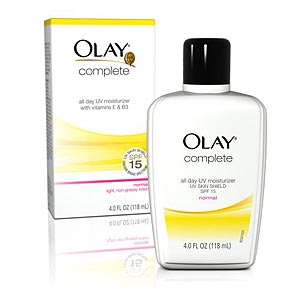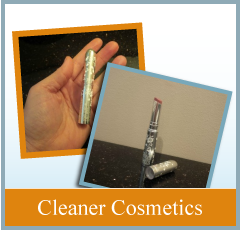I’ve been making my way through Adria Vasil‘s book Ecoholic Body. In it, she quickly identifies what she refers to as ‘Ecoholic’s Mean 15: Top Body Care Ingredients to Shelve for Good.”
This is fine and dandy as a list, but as I noted in my post last week, I simply don’t want to have to spend the time reading all the ingredients and cross-checking them against Ecoholic’s Mean 15. That’s why a store like Terra20 is very appealing to me.
You might think I exaggerate when I say I just don’t want/have the time to do this kind of ingredient cross-checking. So in the interests of research (and plain old curiosity), I thought I’d take a look at the makeup that I put on my face daily. I do the basics: Lotion, Foundation on t-zone, and Mascara. Without these, I look like hell. Don’t get me wrong, that doesn’t actually stop me for going around all weekend without makeup on. But every weekday morning, I do this makeup routine without fail. I have never, ever, gone to work without makeup on. I just can’t do it.
So, first things first. The Lotion. I’ve been using Olay Complete All Day Moisturizer.
 You would think it would be easy to take the list and cross-check against ingredients. But not so much. What happens is that a grouping of particular chemicals are listed as one category in Vasil’s list. So, for example, her #13 is “Siloxanes.”
You would think it would be easy to take the list and cross-check against ingredients. But not so much. What happens is that a grouping of particular chemicals are listed as one category in Vasil’s list. So, for example, her #13 is “Siloxanes.”
“Siloxanes: Pass on cyclo-ingredients that end in “-siloxane” or “-methicone.” Cyclotertrasiloxane (D4) and cyclopentasiloxane (D5) are siloxanes (silocone-based polymers) that have been recognized as toxic to fish and aquatic life and stay in the environment for way too long. Cyclomethicone is a mixture of D4, D5 and D6 siloxanes. Environment Canada is in the process of restricting them, but it could take years, so do your own screening.”
So, it’s not just that I’m lazy (although there is an argument that could be made there), it’s that I now need to screen through the ingredient list of anything chemical-sounding and cross-check it against the D4, D5, and D6 siloxanes. And have you noticed how small the font is on the back of a makeup bottle? This could induce migraines, people!
But here goes … here is the list of all things that I cannot recognize and sound like they could be suspect:
Octisalate
Avobenzone
Homosalate
Octocrylene
Polyethylene
Dimethicone
Niacinamide
Pentylene Glycol
Panthenol
Tocopheryl Acetate
Isohexadecane
Polysorbate 60
Dimethiconol
PEG 4 Laurate
PEG 4 Dilaurate
Iodopropynyl Butylcarbamate
PEG 4
Stearic Acid
Cetearyl Glucoside
Hydroxyethyl Acrylate (Sodium Acryloyldimethyl Taurate Copolyme)
Methylparaben
Ethylparaben
Propylparaben
Disodium EDTA
PEG 100 Stearate
Out of this list (which is far easier to scan once they are in a list form like this actually), none seem to have the “-siloxane” but I do see one with the “-methicone” ending: Dimethicone.
Now, what is Dimethicone and will it cause direct harm to me? It would seem there’s a good chance of that, at least according to David Suzuki Foundation (bold font is my own emphasis):
Also, the European Union classifies D4 as a endocrine disruptor, based on evidence that it interferes with human hormone function, and a possible reproductive toxicant that may impair human fertility. In laboratory experiments, exposure to high doses of D5 has been shown to cause uterine tumours and harm to the reproductive and immune systems. D5 can also influence neurotransmitters in the nervous system. (source: The “Dirty Dozen” Ingredients Investigated in the David Suzuki Foundation Survey of Chemicals in Cosmetics, 2010, page 12)
Great. That sounds like the perfect thing to be smearing all over my skin every morning, doesn’t it? And that is just ONE of the ingredients from the list of ingredients!
So I went through the list and cross-checked them against Vasil’s “Mean 15.” The end result was that my facial moisturizer included at least 5 of the 15. It was easy for me to notice the Parabens since there were three ingredients ending in “-paraben.” These, according to Vasil and other sources, are an estrogen-mimicking family of preservatives that preliminary studies have found in breast cancer tissues. The other ingredient that was easy to notice was the number of “PEG” ingredients — 4 in total. PEGs are often contaminated with a substance that is classified as a human carcinogen.
All in all, checking the ingredients on my moisturizer — which is just one of the things I use each morning — has been quite discouraging. I’d like to believe that folks like Vasil and Suzuki are just alarmists. But logic tells me that the cumulative use of these kinds of ingredients must have an effect on our bodies and our environment.
I was going to do this process for all three products: the lotion, foundation, and mascara. But now I’m tired, and I can see this is going to take me a while. Just a quick glance, however, at their ingredient lists reveals all I need to know … same story, same type of ingredients.
I know what I need to do. I need to take this step (even though it’s just one step, and a small one at that) and change my makeup products. I have always taken the time to carefully screen body care products for my children — from their diaper creams to their shampoos — and yet, I have continued to turn a blind eye on my own body care products. Typical Mom, eh?
















Speak Your Mind